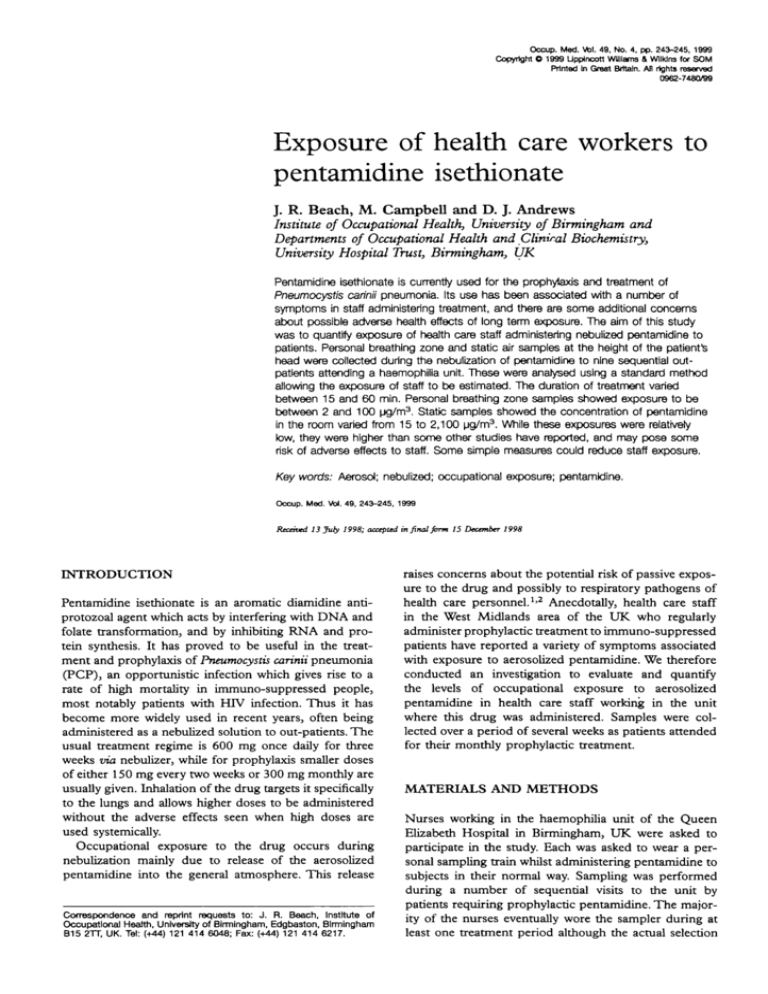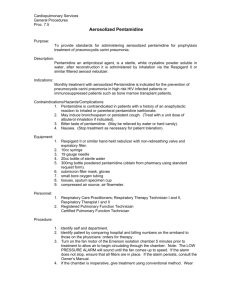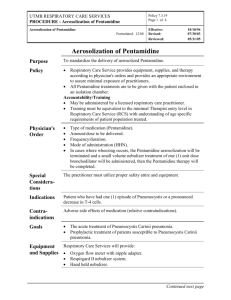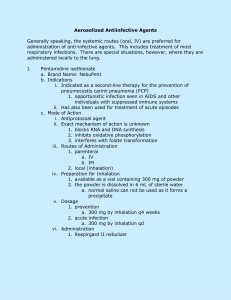
Occup. Med. Vol. 49, No. 4, pp. 243-245, 1999
Copyright O 1999 Uppincott Williams & WIIHra for SOM
Printed in Great Britain. AD rights reserved
0962-7480/99
Exposure of health care workers to
pentamidine isethionate
J. R. Beach, M. Campbell and D. J. Andrews
Institute of Occupational Health, University of Birmingham and
Departments of Occupational Health and Cliniral Biochemistry,
University Hospital Trust, Birmingham, UK
Pentamidine isethionate is currently used for the prophylaxis and treatment of
Pneumocystis carinii pneumonia. Its use has been associated with a number of
symptoms in staff administering treatment, and there are some additional concerns
about possible adverse health effects of long term exposure. The aim of this study
was to quantify exposure of health care staff administering nebulized pentamidine to
patients. Personal breathing zone and static air samples at the height of the patient's
head were collected during the nebulization of pentamidine to nine sequential outpatients attending a haemophilia unit. These were analysed using a standard method
allowing the exposure of staff to be estimated. The duration of treatment varied
between 15 and 60 min. Personal breathing zone samples showed exposure to be
between 2 and 100 ug/m3. Static samples showed the concentration of pentamidine
in the room varied from 15 to 2,100 ug/m 3 . While these exposures were relatively
low, they were higher than some other studies have reported, and may pose some
risk of adverse effects to staff. Some simple measures could reduce staff exposure.
Key words: Aerosol; nebulized; occupational exposure; pentamidine.
Occup. Mod. Vol. 49, 243-245, 1999
Received 13 July 1998; accepted in final form 15 December 1998
INTRODUCTION
Pentamidine isethionate is an aromatic diamidine antiprotozoal agent which acts by interfering with DNA and
folate transformation, and by inhibiting RNA and protein synthesis. It has proved to be useful in the treatment and prophylaxis of Pneumocystis carinii pneumonia
(PCP), an opportunistic infection which gives rise to a
rate of high mortality in immune-suppressed people,
most notably patients with HIV infection. Thus it has
become more widely used in recent years, often being
administered as a nebulized solution to out-patients. The
usual treatment regime is 600 mg once daily for three
weeks via nebulizer, while for prophylaxis smaller doses
of either 150 mg every two weeks or 300 mg monthly are
usually given. Inhalation of the drug targets it specifically
to the lungs and allows higher doses to be administered
without the adverse effects seen when high doses are
used systemically.
Occupational exposure to the drug occurs during
nebulization mainly due to release of the aerosolized
pentamidine into the general atmosphere. This release
Correspondence and reprint requests to: J. R. Beach, Institute of
Occupational Health, University of Birmingham, Edgbaston, Birmingham
B15 2TT, UK. Tel: (+44) 121 414 6048; Fax: (+44) 121 414 6217.
raises concerns about the potential risk of passive exposure to the drug and possibly to respiratory pathogens of
health care personnel.1'2 Anecdotally, health care staff
in the West Midlands area of the UK who regularly
administer prophylactic treatment to immuno-suppressed
patients have reported a variety of symptoms associated
with exposure to aerosolized pentamidine. We therefore
conducted an investigation to evaluate and quantify
the levels of occupational exposure to aerosolized
pentamidine in health care staff working in the unit
where this drug was administered. Samples were collected over a period of several weeks as patients attended
for their monthly prophylactic treatment.
MATERIALS AND METHODS
Nurses working in the haemophilia unit of the Queen
Elizabeth Hospital in Birmingham, UK were asked to
participate in the study. Each was asked to wear a personal sampling train whilst administering pentamidine to
subjects in their normal way. Sampling was performed
during a number of sequential visits to the unit by
patients requiring prophylactic pentamidine. The majority of the nurses eventually wore the sampler during at
least one treatment period although the actual selection
244
Occup. Med. Vol. 49, 1999
of the nurse to wear the sampling device depended
simply on which one was administering treatment at the
time of sampling. The duration of sampling was fixed as
the time taken to treat a single patient, the sampling
equipment being started at the beginning of the treatment episode and switched off immediately afterwards.
Patients received their treatment in a room within
the haemophilia unit which was also used for other
procedures, and which included refrigerated storage
facilities. Patients usually sat in a chair positioned near a
window which was kept open whenever possible. At the
time of the survey the unit used a System 22 nebulizer
and 'Mizer' reservoir device (Medic Aid, Pagham,
UK) connected to a compressor to aerosolize the drug.
Patients usually inhaled using a mouthpiece rather than a
mask, and exhaled air was exhausted via a "F piece
with one-way valves through a large bore tube directly
out of the adjacent window. Theoretically, all exhaled
pentamidine was released outside the treatment room.
The room had no mechanical ventilation, the only source
of fresh air being the window which was kept closed during bad weather. The duration of treatment was usually
20-30 min.
Staff caring for patients did not usually remain in the
room during treatment but did enter intermittently to
check on progress, and occasionally had to enter to
remove supplies from the refrigerated storage. It was
sometimes necessary for staff to stay with patients
throughout treatment if they were particularly ill or
became distressed because of coughing or other symptoms. Patients were given additional instructions aimed
at reducing pentamidine release into the room. These
included switching off the compressor when removing
the mouthpiece or mask, for example when taking a
drink or when they needed to cough.
Personal samples were collected from the breathing
zone (PBZ) of the nurses to quantify exposure of staff
during treatment. The nurses wore a harness carrying a
pump drawing air at 2 L/minute through an open faced
cassette holding a 37 mm, 5 |im pore polyvinyl chloride
membrane filter.3-4 Additional static (S) samples were
collected using a similar technique from a position at the
patient's head-level, one metre each side of the patient, to
evaluate the amount of pentamidine released into the
room due to equipment leakage during coughing bouts,
nose breathing or other 'improper' use of the nebulizer.
Control samples were also collected from the treatment
room when not in use and from the library at the Institute of Occupational Health.
After sampling the filters were collected and pentamidine isethionate extracted using 3 ml aliquots of
50:50 ethanol:water with 0.085% phosphoric acid and
0.04% tetramethylammonium chloride in an ultrasonic
bath for 10 min. Quantification was performed using
high performance liquid chromatography (HPLC) using
aTechsphere 5 |jm C8 column, acetonitrile:water (30:70
v/v) mobile phase containing 0.085% phosphoric acid and
0.04% tetramethylammonium chloride, and fluorescence
detection.3'4
Table 1. Results of personal breathing zone (PBZ) and static exposure assessments in the treatment room
PBZ
Patient
1
2
3
4
5
6
7
8
g
Geometric mean
frg/m3)
100
100
20
20
60
2
6
7
go
23
Right side
of patient
Qjg/m3)
Leftside
of patient
(iiglm3)
Sample
time
(mins)
300
20
100
400
100
70
150
140
400
140
2,100
400
200
400
50
130
130
170
150
224
15
30
15
20
20
60
35
15
40
(2QT
•Arithmetic mean.
RESULTS
Samples were collected during a total of nine treatment
periods with nine separate patients. Results for each
sample are shown in Table 1. The duration of treatment
ranged from 15-60 min depending upon how often the
treatment needed to be interrupted by the patient to
maintain comfort. The nurses wearing the sampling
equipment felt that these treatment episodes were typical
of their working practice. None of the control samples
taken from the treatment room when not in use or from
the library at the Institute of Occupational Health, contained any detectable pentamidine.
DISCUSSION
The results obtained in the study showed that there
was quantifiable exposure to pentamidine isethionate in
health care staff working in this unit. In other health care
settings with comparable work practices there is likely to
be a similar level of exposure. However it is difficult to
quantify the risks to health that might result from this
exposure, as only limited information is available on
the health effects of long-term exposure to pentamidine
isethionate, particularly at the relatively low levels typical
of occupational exposure, and exposure in this study was
relatively variable, with no clear relationship being apparent between the results of personal sampling and static
sampling. We do not believe this is due to any methodological problems but simply reflects the true distribution
of the data. Unfortunately, the number of samples was
not sufficient to identify the factors which might contribute to greater or lesser exposure.
Currently, the Health and Safety Executive has set no
occupational exposure limit for pentamidine.5 Exposure
levels were below a provisional control limit which has
previously been recommended by the manufacturer
(1 mg/m3 as an 8-hour time weighted average),6 although
the supplier does not currently recommend any such
limit. It was unclear which adverse effects had been considered in arriving at this putative exposure limit, but any
such exposure limit must be relatively imprecise given
the paucity of available data on occupational exposure.
J. R. Beach et a/.: Exposure cf health care workers to pentamtdlne isethionate
One previous study has reported similar levels of exposure when sampling was performed immediately after a
treatment,7 whereas others have reported somewhat
lower levels and it is relevant that in these studies an
exhaust filter was used.8'9 Acute bronchospasm following
low-level exposure to pentamidine has been reported
to occur in a nurse observing the administration of
nebulized pentamidine to a patient, and in a visitor of a
patient receiving similar treatment.10 Additionally, in a
group of nurses with broadly comparable occupational
exposures to these (< 0.03 ug/m3 to 62.2 ug/m3) a mean
cross-shift decrease in FEV1 of 140 mis was detected.11
It has also been suggested that low doses of pentamidine may carry a risk of teratogenesis as it is able to
inhibit the enzyme dihydrofolate reductase.12'13 The
manufacturer's hazard safety data sheet does advise that
the exposure of pregnant women to pentamidine should
be minimized.6 It must also be borne in mind that unlike
patients, staff receive no benefit from their exposure to
pentamidine, and thus a lower level of risk of adverse
effects is likely to be acceptable for staff than that for
patients. COSHH (Control of Substances Hazardous to
Health Regulations) assessments have been completed,
but again, perhaps because of the paucity of available
information about the adverse health effects of occupational exposure to pentamidine, sufficient emphasis may
not have been given to some risks.
Assessment of the work practices in the haemophilia
unit indicated that some simple controls were already in
use in an attempt to reduce exposure. For example, staff
were aware that they should spend a minimum amount
of time during the room during patient treatment, and
that they should avoid entering to collect supplies from
the refrigerators until treatment had finished whenever
possible. A number of measures were recommended to
help reduce exposure both to pentamidine and airborne
pathogens including: the use of an exhaustfilter;increasing the general ventilation in the room; regular checks of
equipment seals; building an observation window into
the wall or door of the room; not using the room for a
period after each nebulization and moving the refrigerated storage elsewhere. Establishing a negative pressure
within the room relative to the adjacent room and corridor
would help reduce the risk of exposure to staff not in the
treatment room, and the introduction of a device to time
nebulization to inhalation (an inhalation dosimeter) may
also be useful. In addition to airborne exposure there is
the potential for some skin contamination and ingestion
of pentamidine. The potential for exposure via this route
is unclear as surface wipes were not performed, but again
some simple housekeeping measures could help control
this. Finally, many of the staff, although concerned, were
unsure of possible health risks and appropriate control
measures, emphasizing the importance of information
and training in the management of chemical hazards in
the workplace. A complete account of effective control
measures is contained in the guidance recently provided
by the British Occupational Hygiene Society.14
245'
Although the quantity of data here is limited, we
believe it is important. Many health service staff work
with a wide variety of toxic chemicals used specifically
because they are biologically active. Limited resources,
time pressures, the prioritization of patient care and complacency arising from familiarity may all contribute to
poor control in some circumstances. This data emphasizes
that risks to health care staff arising from pharmaceutical
agents continue to exist, but that relatively simple and
inexpensive measures may significantly reduce these
risks.
ACKNOWLEDGEMENTS
We are grateful toT. Chando for her help with the collection and analysis of data.
REFERENCES
1. Dupon M, Malou M, Rogues AM, Lacut JY. Drug points.
Acute eosinophilic pneumonia induced by inhaled pentamidine isethionate. Br Med J 1993; 306: 109.
2. Leigh TR, Millett MJ, Jameson B, Collins JV. Serum litres
of Pneumocystis carinii antibody in health care workers caring for patients with AIDS. Thorax 1993; 48: 619-621.
3. National Institute for Occupational Safety and Health.
NIOSH Manual ofAnalytical Methods, Fourth Edition. Pentamidine Isethionate: Method 5032. Cincinnati, OH (USA):
NIOSH, 1992.
4. Tucker SP, Belinky BR, Seitz TA, Foley GD. Determination of pentamidine isethionate in air. Am Ind Hyg Assoc J
1993; 54: 628-632.
5. Health and Safety Executive. Occupational Exposure Limits
1998. London, UK: HSE Books, 1998. EH40/98.
6. Rhone Poulenc Rorer Ltd. Material Safety Data Sheet,
Pentacarinat Ready-To-Use Solution. January, 1991.
7 Ros JJ, Langen MC, Stallen PC, Lenderink AW. Pentamidine aerosols and environmental contamination: healthcare workers at risk. Pharm World Set 1996; 18: 148-152.
8. Montgomery AB, Corkery KJ, Brunette ER, Leoung GS,
Waskin H, Debs RJ. Occupational exposure to aerosolized
pentamidine. Chest 1990; 98: 386-388.
9. Decker JS, Seitz TA, Shults RA, et al. Occupational
exposures to aerosolized Pharmaceuticals and control
strategies. ScandJWork Environ Health 1992; 18(Suppl 2):
100-102.
10. Doll DC. Aerosolised pentamidine [letter]. Lancet 1989; ii:
1284-1285.
11. Balmes JR, Estacio PL, Quinlan P, Kelly T, Corkery K,
Blanc P. Respiratory effects of occupational exposure to
aerosolized pentamidine. J Occup Environ Med 1996; 38:
330-331.
12. WaalkesTP, Makulu DR. Pharmacologic aspects of pentamidine. Natl Cancer Inst Monogr 1976; 43: 171-176.
13. Ito S, Koren G. Estimation of fetal risk from aerosolized
pentamidine in pregnant healthcare workers. Chest 1994;
106: 1460-1462.
14. British Occupational Hygiene Society special interest group
for the NHS. COSHH Guidance Note 0396: Pentamidine.
Derby, UK: BOHS, 1997.






